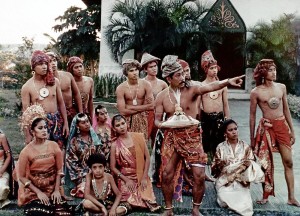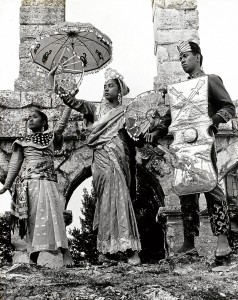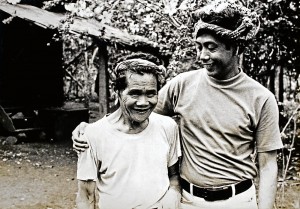
Like an old house in some Gabriel Garcia Marquez novel, the Ramon Obusan Folkloric Group’s (ROFG) headquarters in Pasay City is alive with memories of the past and activities rooted in the present.
The house where the late National Artist for Dance lived and worked had been modelled after a traditional 1930s chalet with open courtyards, and is cluttered with artifacts, musical instruments, textiles and objects that could easily fill a museum dedicated to Filipino traditional arts.
But there is nothing hallowed or funereal about the house where the members of the ROFG rehearse and where the late teacher had amassed a collection of traditional arts. The objects are used in shows and lecture demonstrations and are handled with both care and gusto by the young dancers who are trained to use, say, a Bontoc kalasag shield, an Itneg blanket, a sequined Maranao umbrella, with the same ease and confidence as they do iPhones and iPads. The objects, like the house itself, are part of the living and constant ritual of performance.
Senior members of the company, as well as the very young members of the Batang ROFG affiliate company, come for rehearsal, fresh from school or their day jobs, dressed in their jeans and baby tees , their bonnets and caps and backpacks, they are children of their generation. But upon entering, a transformation takes place.

First, the ritual of the pag-mano, in which the hands of the seniors are pressed against the foreheads of the youngsters. Now, when there are more than 50 individuals (often the case) in a rehearsal, the ritual can get unwieldy, and I remember that when I started directing the ROFG shows after tito Mon’s death in 2006, I felt that it cut into valuable rehearsal time.
“Huwag ninyo na pong masamain. Ganoon po ang kinalakihan nila dito.” (Please don’t take it badly. That is the way they have been trained here.) This was the explanation that very gently put me in my place. I was merely directing a show. These kids were continuing a dying tradition of respect and reverence.
The second part of the transformation begins when the dancers take of their shows and slippers and rehearse barefoot. It connects them, the late tito Mon, once told me, to the earth, to the ancestors. “Our folk dances were rooted in the cycles of the earth. The dancers have to get a feeling of that connection.”
Rite of transformation
After having reverenced the elders and connected to the earth, the dancers carry out the rest of the rite of transformation. They become Yakan, Kalinga, Badjao, Tagalog, Visayan.
They segue effortlessly from the role of dancer to that of musician, playing agung, gangsa, harpa and banduria while singing with regional accents and guttural gusto. They chant rituals of healing, marriage, death and birth. It helps that the democratic membership policy that tito Mon instituted was all-inclusive.
There are no height requirements, no preferences for standardized, idealized beauty. All tito Mon required was a desire to dance and learn. In costume, the dancers look and move Tausug or Kalinga , Illustrado or taga-bukid, thanks to tito Mon’s copious research and his knack for mixing authentic pieces with newer costumes made from tribal textiles of more recent manufacture.
In the great outdoor kitchen, Dulce “Bing” Obusan, a younger sister who has now taken on the role of executive director of the company, is preparing food for rehearsals. When mealtime comes, the dancers line up for their food and sit among the racks of costumes and the shelves of artifacts to eat and banter.

In one corner of the main rehearsal hall, the portrait of tito Mon, dressed as a Kalinga warrior, stands over his favorite pair of worn bakya, and the dancers sit around this little shrine, with no fear or put-on reverence. When he was alive, these bakya would sometimes go flying over the heads of erring dancers. The memory is still a source of much joking among the members.
These rehearsals are overwhelmingly joyous, and I find myself leaving them with a renewed sense of hope and belief in our country and our young people. These rehearsals are what Pinoy culture is about. The present mixes with the past, roles and rituals are enacted. Always there is a sense of overwhelmingly contentment (even in the hardest times), of pakikia-sama, of community, of coming together for a bigger cause. The young dancers are living a code that tito Mon had always hoped his company would instill. They are being authentically Filipino.
Brother’s legacy
“I am only now getting to know my brother, through his legacy, through the dancers he trained, through the people who support his vision,” says tita Bing, who came home from the States to assume the directorship of the company after her elder brother died.
“Me and my other siblings had been living in the States for a long time. Of course, we knew about his work and we were very proud of his accomplishments. But after he died, we wondered if the company should go on. The family decided that we owed it to his memory and to the many young dancers he had trained and educated, to continue his mission. It has been an uphill climb, but thanks to many supporters and to the perseverance of the senior members, the company is very active today.”
A resident company of the Cultural Center of the Philippines, ROFG, under tita Bing’s directorship has expanded its performance reach to include corporate events, including the recent Asian Development Bank International Conference early this year.
“We try and accommodate as many bookings, while keeping to the vision of my late brother,” tita Bing says. “We are ready to mix with contemporary performers, new forms of music, but we draw the line at bastardizing or excessively theatricalizing the dances in the repertoire.”
The other two aspects that tita Bing and the senior members are very committed to, are socialized pricing for their bookings and the need to respond to schools and dance troupes all over the country that are in need of training. That last aspect is very important to the group.

“We have many affiliate groups all over the country who started out just needing a summer workshop or a dance clinic. What begins as a dance clinic becomes an extended period of mentorship. That way the research of kuya becomes more accessible to all, becomes more widespread. More and more young people—from Tondo’s Smokey Mountain to the Tokyo University in Japan—become acquainted with an aspect of our culture. In many cases, the acquaintance-ship becomes a passion.”
That passion is most charmingly evident with the members of the Batang ROFG. Young school children from the area surrounding the ROFG center have been dancing with the company for over two decades now. Many of them have grown up to become ROFG musicians and dancers. One thing I really love about these kids is watching them imitate the senior dancers as they go through the more rigorous dances in the repertoire like the Maranao sagayan. It is not difficult to imagine that a hundred years ago, it was through such youthful imitation that children imbibed the best and most graceful traits of their race, and continued the traditions of their forebears.
In one room in the center, tito Mon’s vast research is kept. Boxes upon boxes of video material shot in situ are kept in plastic boxes , along with other containers for his field notes and his vast archives.
First meeting
I remember how I first met him in the early ’90s, when we were doing the annual Eidl’Fitr celebrations for the Rasul clan. The events were a yearly offering of the old Glorietta. I wanted the dancers, all magnificently costumed in Southern Islamic gear, to come down the escalator. When I was introduced to the old man, he glared at me when I told him the concept for the opening number.
“Even the pangalay dancers?” he asked, “Do you know I make the the female dancers enter standing on the shoulders of the male? That’s the way it is done. So you want them to come down the escalator, standing on the male’s shoulders? Do you know how dangerous that will be?”
I was about to say that if it was such a “buwis-buhay” opening act, I could just scrap it (tito Mon could be intimidating with his loud voice). But his next statement floored me: “If it will work for an opening in the mall and get people to watch, let’s do it!”
The parade of dancers all moving to the sound of an agong ensemble and coming down on the Glorietta’s two escalators quickly became the signature opening of the Eidl’Fit’r series we did at the Glorietta.
That was the one thing I grew most to admire about Tito Mon, his desire to get modern Filipinos to see how wondrous Philippine culture is.
One time, he proudly showed me a series of notebooks with popular artista on the cover. The difference was that the artista were all garbed in authentic tribal gear! He had come up with the idea of dressing them that way so that their celebrity status could be linked to indigenous wear.
Another time, he called me up to say how kuya Germs (German Moreno) had asked to conceptualize the production numbers of the now legendary “That’s Entertainment” daily show. “I know you will say na ang cheap-cheap ko! Unahan na kita! I want to do this,” he said. “What other TV program will offer me the chance to show our traditional dances?”
When he succumbed to a heart attack six months after the title of National Artist was conferred on him, the CCP asked me to stage his necrological service. It was two days after Christmas and I could not say no. I knew that we did not want to do just a service. tito Mon would have wanted a show.
So we mixed some numbers that he was very fond of with the service. The ending had the dancers enacting the Kalinga funeral rites for a fallen warrior. Their chants and dirges echoed through the darkened hall.
As the casket was brought into the lobby and into the light, hundreds of dancers from the affiliate companies were lined along the CCP entrance and main driveway, all dressed in Filipino costumes from the North to the South. It was as if ghosts of the past had come to claim him as one of their own.
Six years have gone by since that farewell. And the company has survived to mark its 40th anniversary. The show we are currently preparing for is perhaps the most personal we have ever done. There are nods to tito Mon’s roots with the Bayanihan where he was a researcher, there are little “in” jokes about his temper, there are memories and anecdotes.
Senior dancers have come home from all over the world to start rehearsing the numbers they performed in their youth (which makes the mano-po ritual even longer—and more fun).
A group of seven beautiful Japanese students from the Tokyo University are going “mano-a-mano” with the young members, and except for their porcelain white skins are just as Pinoy in their movements as the rest.
The famous “edu-tainment” suites (compendium numbers that shortened regional dances and strung them together with tito Mon’s annotation for lecture tours) will be restaged, along with pièce de résistance like his “Jota Paragua” and ” Kayaw.”
When we do the show this weekend, “The Phantom of the Opera” will be playing in the Main theater above. Despite the naysayers, I thank God that we have no equity problems and I pray to tito Mon that the efforts of his students and dancers and family will pay off, and that kindred spirits who believe in loving, learning about and supporting our own will come to watch. Late last year, when we were planning the show, a title was suggested—“Ugat… Ugnayan… Obusan.” It was approved almost instantly.
I think the reference to a root, to a spreading tree, to intertwined branches reaching to touch the sky, is most apt.
“Ugat… Ugnayan… Obusan” opens on Sept. 21, 8 p.m., at the CCP Little Theater. It runs until Sept. 23.














































